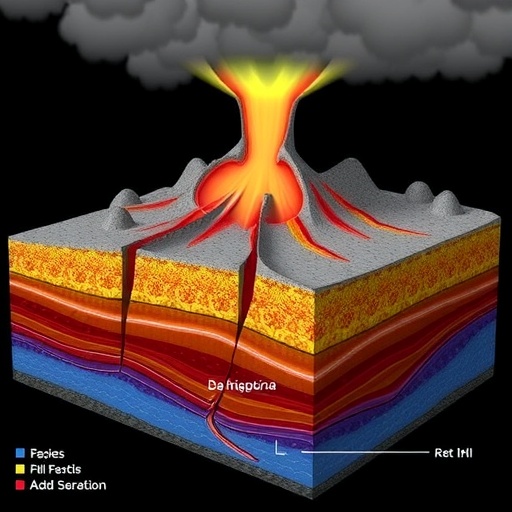Recent advancements in understanding the mechanisms of subduction initiation have shed light on the complexities that govern this geological phenomenon. A pioneering study by Oravecz, Gerya, and Balázs, published in Commun Earth Environ, probes the critical influences of both structural and thermal inheritance on where compression-induced subduction is likely to start. This research addresses long-standing questions about the conditions and factors that facilitate or inhibit subduction initiation, with implications for predicting tectonic behavior.
Subduction zones are critical features of the Earth’s lithosphere, where one tectonic plate is forced beneath another, leading to intense geological activity, including earthquakes and volcanic eruptions. Recognizing the conditions that lead to the initiation of these zones is vital for understanding the dynamic processes that shape our planet. The new research emphasizes the role of inherited geological structures and pre-existing thermal conditions, which interact to steer the location and timing of subduction initiation.
In this groundbreaking article, the authors employ advanced numerical simulations alongside empirical data to explore the interplay between structural and thermal factors in subduction zones. The findings indicate that regions with favorable structural configurations are more conducive to subduction initiation, particularly when coupled with appropriate thermal conditions. The authors argue that previous models that underestimated the significance of structural inheritance have likely oversimplified the complexities involved in these processes.
The study emphasizes that the characteristics of the lithosphere play a crucial role in determining the locations where subduction can initiate. Structural inheritance refers to pre-existing weaknesses in the Earth’s crust, such as faults and folds, which can significantly influence how tectonic forces are translated into subduction processes. The research suggests that in areas where such inherited structures are present, the likelihood of subduction initiation increases dramatically under compressional stress.
Thermal inheritance, on the other hand, relates to the historical thermal conditions of the Earth’s lithosphere. This aspect is equally important, as it affects the viscosity and behavior of rocks at depth. The study reveals that cooler regions of the lithosphere may support the onset of subduction more effectively than hotter regions, where materials behave more ductilely. The combination of these two factors lays the groundwork for subduction initiation, making their relationship a critical focus for future researchers seeking to unravel the intricacies of tectonic activity.
One of the most compelling aspects of this research is the modeling approach employed by the authors. By integrating geological data from various tectonic settings and applying sophisticated computational techniques, they create a comprehensive picture of how structural and thermal factors coalesce to dictate subduction dynamics. This methodology sets a new standard for tectonic studies, showcasing how computational modeling can be utilized to address complex geological questions.
Furthermore, the implications of this research extend beyond academic curiosity; they serve to enhance our understanding of natural disasters associated with subduction zones, such as earthquakes and tsunamis. By identifying the conditions that lead to subduction initiation, scientists can develop better models to predict the locations and potential hazards associated with these events. This insight is crucial in preparing societies for the consequences of tectonic activity.
The authors also delve into the historical context of subduction research, tracing the evolution of ideas about where and how subduction initiates. They highlight significant milestones in the field and how misconceptions about the dominance of thermal over structural factors have evolved. This reflective aspect adds depth to their findings, ensuring that the research is situated within a broader scientific discourse.
Moreover, Oravecz and colleagues call for a reassessment of existing models that oversimplify the mechanisms of subduction initiation. They propose that future investigations should take a multifaceted approach, considering both structural and thermal factors in tandem rather than in isolation. This recommendation is pivotal, as a holistic understanding of these processes is essential to unlock the mysteries of Earth’s tectonic behavior.
In addressing the future of tectonic research, the authors underscore the importance of interdisciplinary collaboration. Geologists, geophysicists, and computational scientists must work hand in hand to refine models and gather more detailed data across various geological contexts. Such collaborations can lead to more robust predictive capabilities, ultimately improving our understanding of not only subduction initiation but also the broader field of plate tectonics.
The findings of this study also have implications for understanding the evolution of mountain ranges and the complex interplay between tectonics and climate. As subduction zones influence the geodynamics of the Earth, they can further impact sedimentation patterns and ecosystem development over geological time scales. The research lays a framework for studying these interdependencies, opening new pathways for investigation.
In conclusion, the study by Oravecz, Gerya, and Balázs serves as a significant leap forward in our comprehension of subduction initiation. By elucidating the roles of structural and thermal inheritance, the authors provide a critical lens through which we can view geological processes. As scientists continue to probe the depths of our planet’s crust, the knowledge gleaned from this research will undoubtedly inform future studies and enhance our understanding of tectonic phenomena.
The exploration of subduction initiation is far from complete, and this study serves as both a milestone and a launching point for further research. As we delve deeper into the intricacies of tectonic processes, it becomes ever more apparent that understanding the Earth’s dynamics requires a nuanced appreciation of its layered complexities. The journey to fully grasp subduction and its implications will continue to inspire geoscientists for years to come.
Subject of Research: Subduction initiation mechanics affected by structural and thermal inheritance.
Article Title: The location of compression-induced subduction initiation controlled by structural versus thermal inheritance.
Article References: Oravecz, É., Gerya, T. & Balázs, A. The location of compression-induced subduction initiation controlled by structural versus thermal inheritance.
Commun Earth Environ 6, 652 (2025). https://doi.org/10.1038/s43247-025-02627-0
Image Credits: AI Generated
DOI: 10.1038/s43247-025-02627-0
Keywords: subduction, tectonics, structural inheritance, thermal inheritance, geological processes, numerical simulations, Earth dynamics, plate tectonics.




